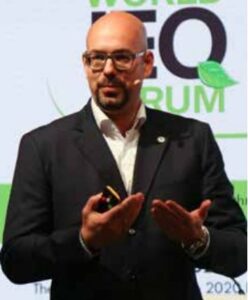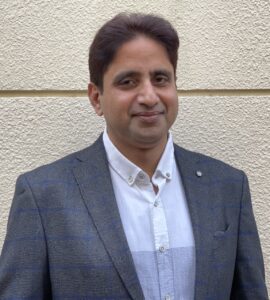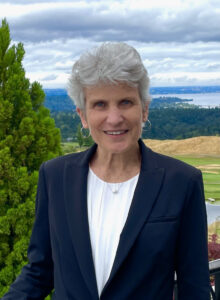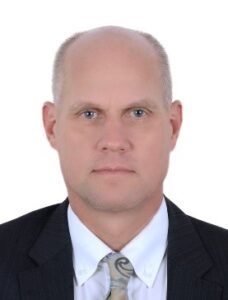Occupant health impact should be the epicentre of all building-related decisions, says Dr Stephanie Taylor, CEO, Building4Health, echoing the dominant sentiment during the 6th edition of the World IEQ Forum
The 6th edition of the World IEQ Forum, on March 16 at the Sweden Pavilion at the World Expo, in Dubai, was as much an opportunity for soul-searching as it was for sharing insights and recommendations, and it delivered on both counts.
The event, held against the backdrop of a receding pandemic, its chastening effect still strong on the psyche, saw a greater-than-usual sense of intensity, when compared to previous editions, and an unrivalled willingness and urgency to seek out solutions. As Dr Stephanie Taylor, CEO, Building4Health, who gave the Plenary Address, put it, “COVID-19 is a hit on the head.”
She epitomised the sense of urgency in implementing IAQ-related interventions, when she said: “We should acknowledge how powerful the indoor environment is on our health. We know we have issues with IAQ (Indoor Air Quality), and we can’t hide from it. Occupant health impact should be the epicentre of all building-related decisions.”

Morten Schmelzer
Dr Taylor pointed out that the living conditions of the human race have changed significantly and that our buildings and technologies are more sophisticated. “By the 19th century, unless in agriculture, most worked indoors,” she said, adding that many buildings became tightly sealed spaces, and windows were no longer operatable. “This saw a rise in certain categories of diseases, despite advances,” she said. “We saw the re-emergence of some pathogenic infectious diseases, and so the question in front of us is, ‘How do we manage our buildings and infection rates?’”
By way of answering the question, Morten Schmelzer, Group Technical Marketing Director, Head of Public Affairs, Systemair, whilst giving the pivotal Industry Leadership Address of the conference, said it’s time to place ventilation and IAQ at the forefront of sustainable HVAC. He pointed out to how many believe that an air conditioning split unit provides fresh air.
They don’t understand that it is providing recirculated air, he said. “That is why we believe we need to strengthen the V in HVAC,” Schmelzer said. “We are used to fresh air in forests and deserts, and so let’s give importance to fresh air in the built-environment.
At the same time, Schmelzer said, focusing on IAQ need not be at the cost of ceding the hard-earned ground related to greater energy efficiency. He spoke of the need for dispelling some common misperceptions that better IAQ is possible only through energy-intensive means. “Achieving fresh air indoors with minimum energy use is not contradicting itself,” he said. “Energy recovery systems help recover heat and cooling. They can reduce cooling demand in building. This Sweden Pavilion is a prime example of utilising this technology. Sixty per cent of cooling is recovered, and only 40% has to be addressed with compressor cooling.”

Tobias Zimmer
Schmelzer said it is important to carefully consider the volume of fresh air introduced in the built-environment. He said it is ideal to achieve a figure greater than 30 cubic metres of fresh air per hour per person and that it is worth debating whether we should aim for 100 cubic metres of fresh air per hour per person.
Highlighting another misperception, Schmelzer said having a high-efficiency filter with lower energy consumption is not contradictory. Carrying Schmelzer’s narrative forward and bemoaning the common practice of using washable filters to save first cost, Tobias Zimmer, Vice President, Global Product Management & International Standards, Camfil, said: “When you wash a filter, it clogs, and energy consumption is tremendous.” Higher efficiency filters, he said, do not equate to higher power consumption.
Yet another misperception, participants pointed out, is that there is little wrong in adopting a homogenous approach to IAQ intervention. Climatic zones constitute an important aspect of consideration, and IAQ interventions need to be adapted accordingly. Indeed, what would work for a temperate zone might not apply to regions that experience high humidity. Speaking from a North America perspective as a member of the audience, Dr Mark Ereth, Mayo Clinic Emeritus Professor, said whilst ventilation and air filtration are important, it is no use if the sole focus is on ventilating to dilute the air if the built-environment has a low Relative Humidity.
So, it is not advisable to look at ventilation and air filtration in isolation. Responding to this, another member of the audience pointed out that the challenge in the Gulf has to do with high humidity which needs to be controlled. He spoke of how the common practice of oversizing of the cooling equipment leads to high humidity in the built-environment. “So, the problem,” he said, “is a bit different here.”
George Berbari, CEO, DC PRO Engineering, elaborating on high humid conditions in the Gulf region, spoke of how a hospital in Abu Dhabi – one of the most humid cities in the world – allowed for 100% fresh air, and made provision for sensible heat recovery. The hospital, he said, installed 100 Refrigerated Tons (RT) of air conditioning to achieve 10 square metres of cooling per ton.
The actual performance, he said, was 12 square metres per ton, and the Relative Humidity was 70-80% for the whole year. In such humid conditions, he asked, can we increase fresh air indefinitely? Should we aim for 100 cubic metres per hour per person? “My biggest challenge in the region is to control Relative Humidity,” he said. “Normally, it should be around 60-65%. The hospital had issues with mildew and fungus, so I introduced run-around coil and double heat recovery, and we managed to bring the Relative Humidity to a bearable 60%, instead of 80%, but we still suffer.”
Berbari pointed out to how LEED called for 30% above ASHRAE Standard 62 and asked why this is the case. “We put constant flow fresh air without any demand control ventilation,” he said. “Why should we not have demand control ventilation in all buildings?” Earlier, we had 60 people occupying the floor, today we have five people, he pointed out, emphasising the need for a responsive approach to ensuring proper building performance.
‘The need for extraordinary IAQ’
Excerpts from a panel discussion aimed at tackling extremely contagious bio-agents with a view to protecting lives in the built-environment…
OMNIA HALAWANI: How have buildings changed since COVID-19?

Jeremy McDonald
JEREMY MCDONALD: I am from the United States. People know they have problems, they know we have issues with AHUs and controls. The K12 facilities are pretty good and have improved. Hospitals are pretty good. We are struggling in nursing homes and multi-family homes. We have high density populations and low RH, which is a prescription for a pandemic.
HALAWANI: Simon, what efforts has AD QCC taken when it comes to COVID-19?

Dr Simon Hugh Miller
DR SIMON HUGH MILLER: Most buildings are not good for infection control. In two years, we have had time to adjust to how we operate our buildings, but in the case of majority of the buildings we have now, it will be difficult to adjust. Lot of technology has been brought in to increase ventilation to control future pandemics. And I know it is a knee-jerk reaction. We need time to understand the right interventions to problems we have had before with IAQ, and in the near future.
DR JENS THOMSEN: The Abu Dhabi Public Health Centre (ADPHC) is the lead entity in Abu Dhabi, when it comes to public health. The ADPHC has done a great job. I am in the Communicable Diseases Department. We were leading the response of public health in Abu Dhabi. The UAE was leading the response to COVID-19 in terms of vaccinations, and of course IAQ is also an important aspect of that response. So, we have had a multi-faceted approach to the problem, including providing guidance, face masks, social distancing, etc. Maybe we have not had too much direct involvement with HVAC, but more of healthcare professionals, the general public and we need to work more closely with the HVAC industry. We are not engineers, we are doctors, epidemiologists, surveillance experts and microbiologists, and we need to work closely together.
HALAWANI: Iyad, what would be a holistic approach to improve IAQ?

Dr. Iyad Al-Attar
DR IYAD AL-ATTAR: The first issue really is that IAQ never gained political traction to become a national priority. The penalty we have paid in this pandemic is bigger, although humanity is equipped with many tools to respond in a better manner. Every time, an enhanced or upgraded IAQ approach is proposed, it is frustrated by structures and decisions-makers at all levels. Every time, we have tried to upgrade filters, and it has a high pressure drop it has been rejected, so we have to bring renewables into the energy mix. We have an addiction of washable filters. If not washable, it is not going to be used. We have paid a hefty penalty by sticking to such a strategy. The rising tide of air pollution has been on for many years, and we have never tackled it. We demand filtration standards but they are poorly followed and poorly understood. We are asking for smart buildings. We need to answer the new question this pandemic has brought upon us today.
HALAWANI: Dr Rohit, could you give us a clinical perspective. Are we ready for countering the next pandemic? We would like to hear your thoughts on prevention versus cure.

Dr. Rohit Pradhan
DR ROHIT PRADHAN: COVID-19 in the last two-and-a-half years has demanded a lot of effort from the medical society and has taught us that we need to be better prepared for the future. The indoor environment has provided a good opportunity for the spread of germs, so we need better planning of ventilation in hospitals, though I have been fortunate to work in a hospital with good-infection control measures. In many countries, though, there is big scope to develop. It is very important to achieve a pollution-free and trigger-free environment, so we need better preparation.
HALAWANI: Dr Rohit, do you feel FM has adapted and has made any changes from pre-COVID to post- COVID?
DR PRADHAN: FM has geared up adequately and definitely changed.
HALAWANI: Dr Stephanie, if we are to quantify IAQ, how can we do it?

Dr. Stephanie Taylor
DR STEPHANIE TAYLOR: It is a very complicated question, but it is critical we aim to do that. With COVID, the concept of IAQ has moved from hospital to everyone. I think we have to create visibility on IAQ.
HALAWANI: Regulation or visibility?
MCDONALD: I believe carrots and sticks would work. In US, we have both. A T&B contractor has to certify. But what happens after occupancy? Nothing happens. The maintenance person is well-meaning but is helpless if he does not have the budget. The folks at the ground level know the problem. I would like to see some sort of an annual check, just like with fire protection. Unless we have a system in place where can we check?
DR AL-ATTAR: Quantifying is key, but it is half the job done. The second part that is essential is having an HVAC system that responds to the IAQ changes. I think sensors, filter performance and HVAC performance needs to be holistic performance. Filtration is not the only reason why IAQ is getting worse, and it is not the only solution. We need the right coordination to start on what we are up against.

Dr Jens Thomsen
DR THOMSEN: Quantification of IAQ? I cannot directly answer that, but in the last couple of years, we have quantified health effect of poor air quality. So, it is possible to attribute burden of diseases owing to pollutants. The University of North Carolina and Abu Dhabi have developed the UAE Burden of Disease Model. And we have tried to estimate what the effect of these are. We call them episodes. For example, the Burden of Disease model has been updated, and [we were able to conclude that] 46 people in Abu Dhabi died due to [poor] IAQ. The work involves epidemiological studies, the study of the relation between pollution and diseases and validating international studies with local data. We conducted the ‘500 Households Survey’, where we went to 500 households. And from all of these, we tried to find out the correlation. So, we can quantify not IAQ but the health effect of poor quality. It is available in the public domain.
BASSEL ANBARI (Energy International; member of the audience): With this pandemic, everyone’s attention was on IAQ. Has Abu Dhabi or the UAE enforced or developed an IAQ-related standard? And how is the government enforcing the standard during the construction period?
DR MILLER: It goes to Dr Stephanie’s point on how you tackle the situation. It is acceptable to have viruses in the air. To design a specific policy for schools, malls and other public buildings is difficult, because you have to put a lot of interventions, which are costly. So, it is easier to stop people from coming in – if having COVID, they can’t enter. Whether that is the approach going forward to the next pandemic is a question.
MARK ERETH (Mayo Clinic Emeritus Professor; member of the audience): Excellent panel! I am wondering if we could consider proposing something to monitor. PM 10 is monitored. We know particle tests are reasonable surrogates for pathogens. With PM 2.5, it is a bit non-specific.
DR TAYLOR: It is fairly large. If PM2.5, it reaches our alveoli. The virus itself is teeny tiny, but while useful to have surrogate metrics like 2.5, to control that would be useful. I would do a lot of testing. The particle count we are trying to establish… buildings are like human bodies. Check the oxygen level pressure, etc. Likewise, check the particle count, VOCs. So, we need to think about buildings like human bodies and establish a benchmark and tackle it.
ERETH: Certainly, instantaneous results are not going to be possible. Commissioning standards and ongoing standards are needed. With ultrafine particles, I might push to have monthly standards and continuous measures to look at the average. Eight-hour exposure of burst of CO2 .
MCDONALD: I 100% agree. In the US, there is a practice of monitoring all variables, and people are talking about PM, VOCs, just like we are talking about heartrate. So, we don’t have another terrible pandemic!
HALAWANI: That is why we need to capitalise on increased talk to effect change.
(To be continued in the May 2022 issue of Climate Control Middle East)
Copyright © 2006-2025 - CPI Industry. All rights reserved.